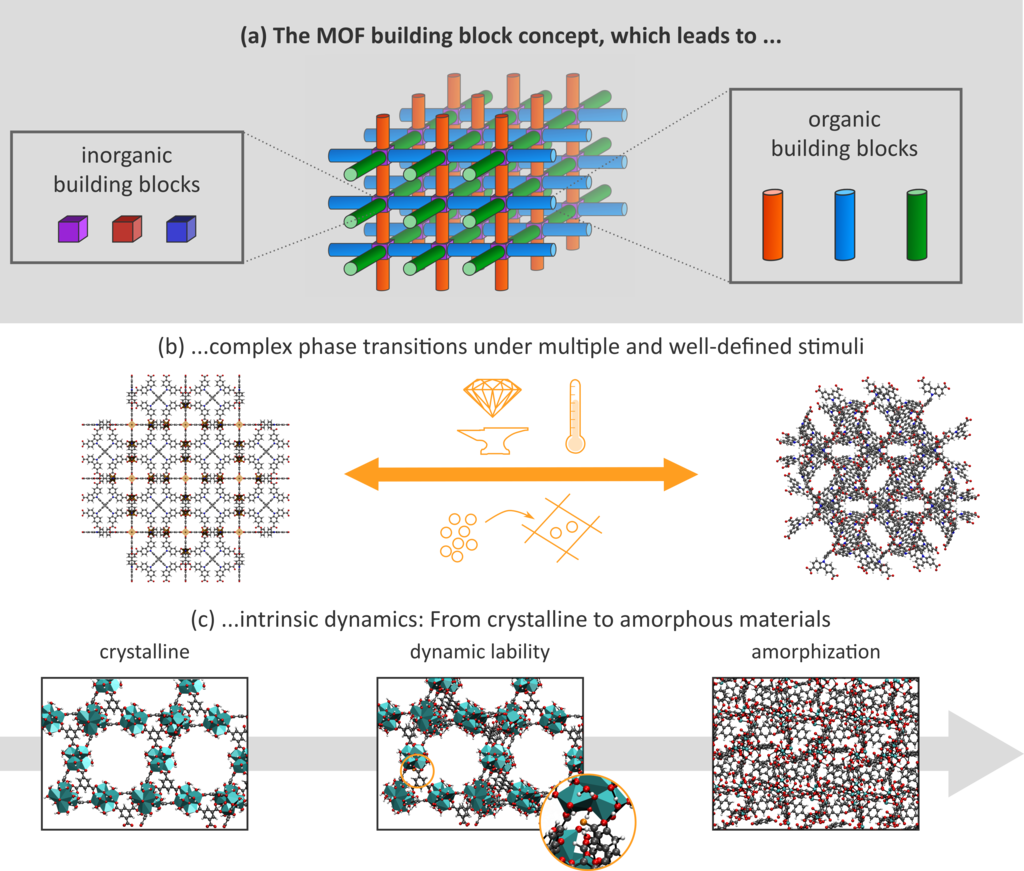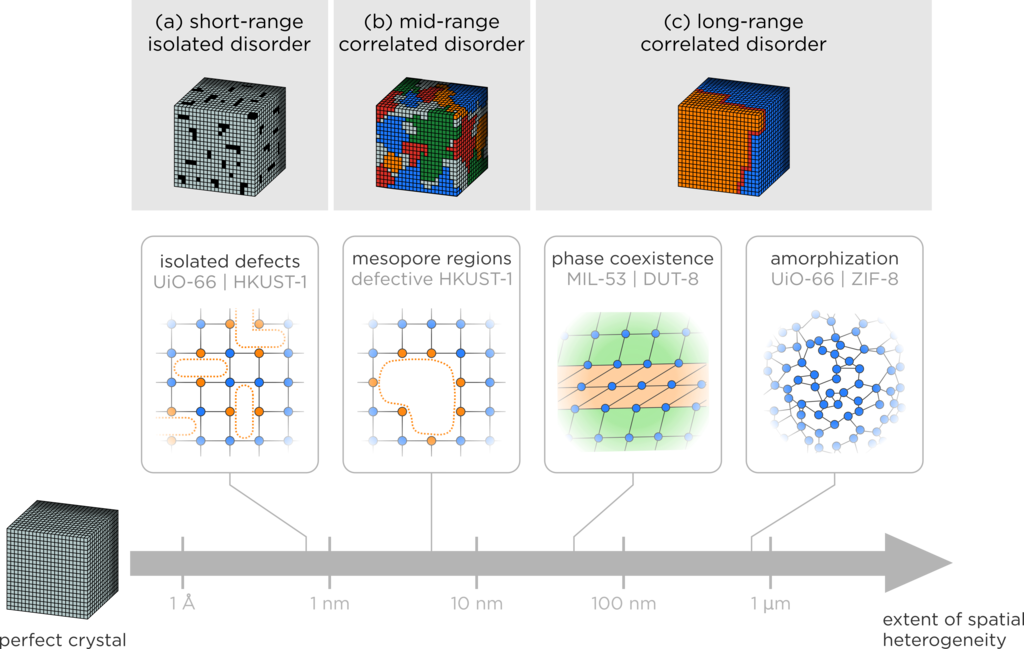Correlating space and time: Towards an understanding of how defects alter the spatiotemporal response of metal-organic frameworks
Correlating space and time: Towards an understanding of how defects alter the spatiotemporal response of metal-organic frameworks
Promotor(en): V. Van Speybroeck /28118 / Model and software development, Nanoporous materialsBackground and problem
Metal-organic frameworks (MOFs) are akin to high-tech K’nex structures. They are composed of well-defined building blocks of a few tens of atoms each and, depending on how these building blocks are combined, can exhibit exotic phenomena that are not encountered in more conventional materials, such as transitions between different solid-state phases (see Figure 1).1 Besides these practical applications, MOFs are also exciting from a fundamental point of view, as even single-atom alterations in their building blocks may induce distinct changes in their macroscopic behavior, for instance suppressing phase transitions. While enormous efforts have been undertaken to understand these effects, two major challenges have been encountered in recent years. First, dynamic phenomena in MOFs occur on strongly disparate time scales – from rapid atomic movements to relatively slow solid-state phase transitions – which are difficult to capture with a single method. Second, the dynamics in MOFs is strongly impacted by spatial disorder in the material (see Figure 2) and by the size of the MOF crystals. However, such spatially dependent dynamic behavior is to date a largely unexplored area as current computational and experimental techniques are yet unable to correctly take these effects into account.

Figure 1: Panel a shows the building block structure of metal-organic frameworks (MOFs), which gives rise to complex dynamics in the material, exemplified in panels b and c.
Given these considerations, we recently coined the term “spatiotemporal evolution of a material” to refer to the dynamics of the material and its entanglement with the material’s spatial properties.2 Fundamental insight into the spatiotemporal evolution of MOFs would open up new perspectives to engineer their responses, giving access to new application areas such as the selective recognition of molecules or a tuned history-dependent response upon external stimuli. However, a conditio sine qua non to study spatiotemporal phenomena in MOFs is to first construct realistic models of defective materials on length scales that extend over tens of nanometers and investigate how this spatial disorder affects the dynamic response.

Figure 2: Overview of the different types of disorder in MOFs and the length scales on which they occur.
Goal
In this thesis topic, we intend to construct realistic models for a series of MOFs which are known to demonstrate intrinsic spatial disorder on various length scales (see Figure 2), and systematically investigate, for the first time, the full extent to which this spatial disorder impacts phenomena such as phase transformations in realistic MOFs. First, experimentally observed mesopores in these materials (Figure 2b) will be generated based on a Wulff shape analysis, which takes into account that certain facets require less energy to be cleaved.3 In this analysis, shown in Figure 3a, the total surface energy for each combination of fundamental mesopore shapes will be determined, and the optimal Wulff shape will be extracted following an approach that has been used to successfully determine the morphology of crystals. Second, disorder on smaller length scales (Figure 2a) will be incorporated by either starting from the symmetry operators of the defect-free material, similar to ref. 4, or via Monte Carlo-based procedures akin to the generalized quasi-chemical approximation.5 These approaches become increasingly difficult the larger the material under study, and a judicious selection of the most appropriate methods at these various length scales will be necessary. The constructed MOF models will be verified via quantitative spectroscopic techniques such as infrared, Raman, or nuclear magnetic resonance spectroscopy, or by using total scattering analyses.

Figure 3: Systematic procedure to create realistic MOF models containing both (a) mesopores and (b) different types of short-range disorder.
A second task in this thesis is to perform large-scale dynamic simulations to probe the spatiotemporal response of realistic MOF models under experimental temperatures and pressures. To this end, we will employ our internally developed force fields to perform GPU-based simulations via the openMM high-performance toolkit. This will yield unique insight in how these realistic defects form and how they affect the stability of the material, further paving the way to design defect-engineered MOFs for specific applications.
- Study programmeMaster of Science in Engineering Physics [EMPHYS], Master of Science in Physics and Astronomy [CMFYST]Keywordsspatial disorder, spatiotemporal response, Metal-organic frameworks, mesopore formation, symmetryReferences
1M. Eddaoudi, D.B. Moler, H. Li, B. Chen, T.M. Reineke, M. O’Keeffe, O.M. Yaghi, Acc. Chem. Res. 34: 319, 2001.
2V. Van Speybroeck, S. Vandenhaute, A.E.J. Hoffman, S.M.J. Rogge, Trends Chem. 3: 605, 2021.
3G.D. Barmparis, Z. Lodziana, N. Lopez, I.N. Remediakis, Beilstein J. Nanotechnol. 6: 361, 2015.
4S.M.J. Rogge, J. Wieme, L. Vanduyfhuys, S. Vandenbrande, G. Maurin, T. Verstraelen, M. Waroquier, V. Van Speybroeck, Chem. Mater. 28: 5721, 2016.
5A. Schleife, M. Eisenacher, C. Rödl, J. Furthmüller, F. Bechsted, Phys. Rev. B 81: 245210, 2010.
